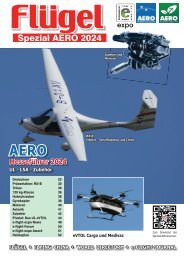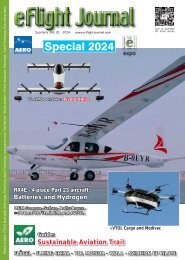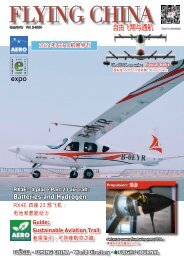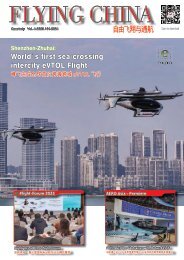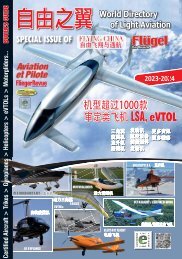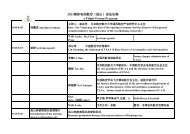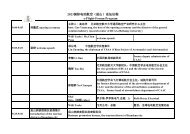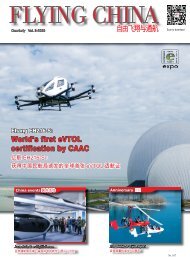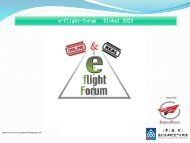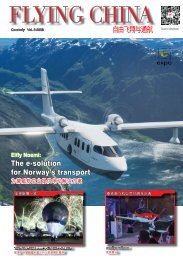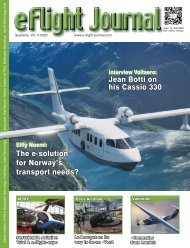eflight-journal01-36-efJ_02-2017Web
Create successful ePaper yourself
Turn your PDF publications into a flip-book with our unique Google optimized e-Paper software.
Electric Aviation, VTOLS, Multicopter, Rotor wings, Fixed Wing, Hybrid Technoilogy, Rule making news, Test Reports * Electric Aviation, VTOLS, Multicopter, Rotorwings, Hybrid Technoilogy, Rule making News,<br />
Quarterly Vol. 2-2017<br />
e-flight-forum<br />
Beijing<br />
Oshkosh<br />
e-Venture<br />
Kitty Hawk Flyer<br />
Larry Page’s<br />
e-bike<br />
www.e-fl ight-journal.com<br />
supported by<br />
1st e-Fly-In Switzerland<br />
Smartflyer<br />
Challenge<br />
e-motor<br />
MGM-Compro
E-Flight.<br />
An exciting future.<br />
“By entering the field of highly innovative aircraft propulsion<br />
technology, we‘re opening a new chapter in E-Mobility.<br />
Collaboration with Airbus Group will create new perspectives for<br />
our company and open us up even more to disruptive innovation.“<br />
Siemens President and CEO Joe Kaeser<br />
siemens.com/innovation
e ditorial<br />
Step by Step<br />
AAt the moment you get the impression that light aviation,<br />
even aviation in general, is in the fast lane and is on the way<br />
with Seven-league boots.<br />
This year opened with the Elevate announcement from Uber,<br />
the taxi service, and in autumn two air taxis were seen at the<br />
International Motor Show (IAA) in Frankfurt.<br />
The financial markets as well are investing: Mercedes has<br />
a 10 per cent stake in Volocopter; Lilium has just collected<br />
90 million euros with their vertical-launch project Lilium-Jet.<br />
At the largest car show in the world, the Slovakian Aeromobil-<br />
Flugauto (flight Car) could be seen alongside the Volocopter.<br />
This is quite an interesting approach, but by many, usually<br />
self-proclaimed “experts” tell everyone without being asked<br />
that these devices are completely out when the VTOL aircraft<br />
will comes there.<br />
We, Flying Pages, have been supporting the electrification of<br />
light aviation for years; we have launched the e-flight Expo<br />
and the e-flight show at the AERO and will now be hosting<br />
the e-flight Forum in Beijing this November.<br />
But these rose-colored future-predictions, you may have<br />
heard last month, seems to be a little bit muted. “Our VTOL<br />
vehicle is to be approved as General Aviation / LSA and approval<br />
will be completed in the next two years so that sales<br />
can begin.” If a journalist asks one of the CEO’s this is one of<br />
the stereotypical timetables they like to offer and like to have<br />
quoted by the journalist. Very seldom will a journalist ask further<br />
questions or dig deeper.<br />
However the fact is, although technical problems, which are<br />
undoubtedly still there, can be solved faster with the flood of<br />
money which is now engaging into aviation and even if the<br />
super batteries will come in the following years, one thing,<br />
which nearly all forecasts absolutely underestimate is the<br />
certification.<br />
Remember how long it took to change to the new radios,<br />
how elaborate and laborious it is to get a certification for a<br />
new glass cockpit and how expensive this process is? If you<br />
think of this, then at least a decade - if not even more - will<br />
pass by before autonomous flying, vertical-flight flight-taxis<br />
will be allowed for passenger transport. Admittedly the regulatory<br />
authorities have moved and set a new milestone with<br />
the new Part 23.<br />
However, before a VTOL not only can fly as a prototype but<br />
with certification a lot of water will flow down the Rhine river.<br />
After all, the failure-proof and redundancy systems of this<br />
totally new technology have to be proved and extensively<br />
tested (alone and in combinations). At the moment most e-<br />
planes have a very short time in the air because the required<br />
flight time reserve limits the actual available real flight time to<br />
a few minutes.<br />
Remember how long it took to get the certification for the<br />
first ballistic recovery system, to save a plane in whole for a<br />
GA plane as well as it being very expensive. This was still the<br />
fact although this system was already used in ultralight aircraft<br />
and had already saved dozens of lives.<br />
Bridging Technology<br />
Against this background, it seems to be a good idea to look<br />
first at old-fashioned fixed wing planes equipped with electric<br />
motors and hybrid devices. Then test these planes and<br />
develop the necessary safety standards, approvals and operating<br />
criteria together with the authorities.<br />
So when the VTOL devices really will come, EASA and Co.<br />
already know how to deal with larger battery packs in the air<br />
and which (approval) requirements are to be placed on the<br />
control software.<br />
The next step will then be airplanes with many electric motors,<br />
which may also start vertically in the future. Of course,<br />
where they can take off and land, that is a completely different<br />
question.<br />
If you accept these “normal” e-planes as bridging technology,<br />
then the flight cars with wings, like the aforementioned<br />
Aeromobile or the Carplane, are a step on the way to certificate<br />
an approve of novel electric planes.<br />
But one thing is clear: even if Air taxis are certified and massproduced<br />
in future, most of the novel airplanes (and their<br />
technology) have been developed in the microlight sector.<br />
Only in a deregulated environment a rapid advancing technology<br />
will unfold. In order to make this happen for the electric<br />
flight in the near future, the MTOW for double-seated ultralights<br />
must be clearly raised, best to 600 Kg.<br />
The only alternative is that the EASA will significantly deeggle/deregulate<br />
its classes, starting with the LSA, and adapting<br />
it to the UL world, but this will probably remain forever<br />
only a beautiful dream.<br />
Willi Tacke<br />
2 / 2017<br />
e Flight Journal<br />
3
The Future ofAviation<br />
April, 18.- 21. 2018<br />
Friedrichshafen - Germany<br />
The e-flight-expo<br />
is part of the annual AERO in Friedrichshafen / Germany.<br />
You will find the most advanced electric, hybrid, fuel-cell<br />
and solar aircraft and propulsion systems.<br />
www.e-flight-expo.com
· <br />
<br />
News 171<br />
CERTIFIED I MOTORGLIDERS<br />
O <br />
<br />
<br />
<br />
<br />
<br />
<br />
<br />
<br />
<br />
<br />
<br />
<br />
<br />
World Directory of Light Aviation 2015-2016 171
e Airshow<br />
<br />
AirVenture 2017<br />
Something<br />
for e veryone<br />
This year’s EAA AirVenture event, held 24-30 July 2017 in Oshkosh/USA,<br />
was a great event. While the week’s weather started a little cloudy and<br />
rainy, by the end of the event the weather was as sunny and optimistic as<br />
the people attending the convention.<br />
Big UBER<br />
Show: Chief<br />
Product Officer<br />
Jeff Holden was<br />
able to impress<br />
viewers with his<br />
“fast-talking”/<br />
Speedtalking<br />
presenta-<br />
tion of the<br />
UBER Elevate<br />
program in the<br />
“Theater in the<br />
Woods.”<br />
The CAFE Foundation made their Electric Aircraft Symposium, which usu-<br />
ally is held in California in May, this year for the first time in Oshkosh. On the<br />
weekend before the start of the fair this event sees a lot of interested visitors,<br />
listening to interesting electric lectures from NASA, Siemens, Eviation, Carter<br />
Copter, Sarbust Capital, BRS, e-Flight-Expo, Solar Ship, the GAMA and other<br />
players in the e-flight scene..<br />
14 e Flight Journal<br />
2 / 2017
e Airshow<br />
For the first time the eHang multicopter was presented at an Aviator fair.<br />
Flying Pages presented at Oshkosh 2017 the first “all-electric<br />
magazine,” the eFlight Journal. Zach Lovering, Project Manager<br />
for the VTOL aircraft Vahana at the Airbus subsidiary A3<br />
(pronounced A-Cube), agrees with the publisher of the eFlight<br />
Journal Willi Tacke: It’s great! Airbus showed its A3 project,<br />
which shall have its first take off this fall in Oshkosh along with<br />
its current helicopters.<br />
www.airbus-sv.com<br />
Surefly from the US presented not only the drone system that the<br />
company developed for Amazon, but also their hybrid two-seater called<br />
Workhorse.<br />
The Sitchblade will now fly as an Experimental.<br />
Also the “big planes” representatives show their interest in flying with e-power.<br />
Here you see FAA Administrator Michael Huerta, who has taken the right seat<br />
in the cockpit of a Pipistrel Alpha Electro. On the left is Pipistrel test pilot<br />
Paolo Romagnolli. Through the second door, GAMA Vice President Greg Bowls<br />
explains the latest actions of the GAMA EPIC Commission on Electric Flight.<br />
Detroit Flying Cars is a new player in the competition of Flying<br />
Cars. Through flying with a combustion engine, as a car it is<br />
electric or hybrid.<br />
2 / 2017<br />
e Flight Journal<br />
15
e Innovation<br />
e Training<br />
by Willi Tacke<br />
16 e Flight Journal<br />
2 / 2017
e Innovation e Training<br />
Kitty Hawk<br />
Larry r Page’s<br />
Sky Motorcycle<br />
A seat and handlebars like a motorcycle, a control unit,<br />
four struts and eight propellers – is this the ultralight of the<br />
future? Not likely! But the machine from Kitty Hawk, the<br />
second aviation company from Google founder Larry Page,<br />
is certainly an interesting approach. It’s a single-seat,<br />
manned drone, which is designed to fly under the American<br />
Part 103 regulations (without a pilot license, registration<br />
or airworthiness certificates), but only over water.<br />
2 / 2017<br />
e Flight Journal<br />
17
e Innovation<br />
Control unit:<br />
The Flyer is<br />
controlled by<br />
buttons on<br />
the handlebar<br />
ends.<br />
TThe Kitty Hawk company has been working quietly for more<br />
than two years: People only knew that the money came from<br />
Google founder and Alphabet chief Larry Page and that Page<br />
with Zee Aero (and their work on vertical takeoff airplanes) was<br />
yet another iron in the fire.<br />
Then this past April came the bombshell: shortly after the first<br />
flight of the unmanned Lilium in Germany, Kitty Hawk showed<br />
their project - and the world was amazed! One day before the<br />
big Uber Elevate Summit in Dallas, they showed not an airtaxi<br />
nor autonomous aircraft but instead - in the truest sense a ‘Just<br />
for Fun’ aircraft - an air motorcycle, a jet ski for the sky.<br />
The air moped made its first public appearance at Oshkosh.<br />
The spectacle was scheduled to take place at 9:00 am, and at<br />
8:30am the beach at the Seaplane Base at Lake Winnebago<br />
was slowly filling up - quite unusual, because normally there<br />
in the shade of the old trees, the few people there find it rather<br />
relaxed. First up, Communications Manager Ellen Cohen explained<br />
how the flights would proceed: A flight of three minutes,<br />
landing on the pontoon, battery change, and then a second<br />
flight. Technical questions would only be answered in a limited<br />
way. The flyer could be seen on a floating platform at a footbridge.<br />
The plane was connected via a Datalink to a computer<br />
station, which records, stores and evaluates all data.<br />
Then it’s time. Todd climbs onto the flyer. Assistants take the<br />
propeller guards from the eight twin-blade propellers. There<br />
are a few, small remaining checks and then the propellers howl<br />
to life. The Flyer, with Todd aboard, slowly climbs into the sky,<br />
then he pulls past us and performs some pirouettes and some<br />
fly-bys at different speeds. Sometimes Todd lowers the device<br />
slowly to nearly the water surface, then rises again to its limited<br />
maximum height of about 15 feet. The flyer is equipped with a<br />
laser altimeter that ensures that it does not climb more than 15<br />
feet above the water. “Of course the machine could technically<br />
fly higher,” explained Reichert later in the interview, “but in the<br />
current test phase we have limited the height.” “Why is the pilot<br />
sitting relatively stiffly on the machine?” was another question.<br />
“The machine is piloted by the control units on the ‘handlebars,’<br />
it is not about weight shifting - even though it would react<br />
to it,” says Todd, “but we have found that this is the most precise<br />
method of steering.” There are various buttons on the handlebars<br />
to control the vehicle. The throttle is a small knob on the<br />
left-hand tip of the handlebars. The throttle is used to regulate<br />
the height. On the right handlebar is the ‘pitch’ lever, which allows<br />
you to move the machine back and forth. Using the index<br />
finger on the left hand, another lever, the ‘yaw’ control, rotates<br />
the device around its own axis.<br />
Actually, the machine is not balanced by the pilot’s controls, because<br />
it is - like any other unmanned multicopter - controlled by<br />
several gyros that in turn drive the multiple propellers through<br />
redundant computers.<br />
18 e Flight Journal 2 / 2017
e Innovation<br />
Todd Reichert,<br />
the pilot behind<br />
the mask, is<br />
the head of<br />
Aerodynamics<br />
and Configuration<br />
at Kitty<br />
Hawk.<br />
Then it’s over. After the first landing, there is a<br />
second short flight which goes much like the<br />
first.<br />
After the final landing, the questions are dominated by price, but<br />
Kitty Hawk won’t give away anything, even a price frame they<br />
would announce or confirm. But what is certain: in the fall, the<br />
flyer is to be offered for sale, when the maximum flight time is to<br />
be significantly increased. And if you want, for $100 you can already<br />
become a member of the Kitty Hawk Club, which among<br />
other things will provide a discount of $2000 off the retail price<br />
of the Flyer.<br />
Light weight engines and propellers are designed in-house at Kitty<br />
Hawk for their own production.<br />
While Robertson is still being interviewed, his team stashes the<br />
Flyer on a red pickup truck, ties it down, and then it’s gone<br />
again. In the photos we caught, it becomes clear that it’s still<br />
a prototype: complete with cable ties, loose cables and tape.<br />
But when machines look like that, then you can still try out a lot<br />
of things. The first impression is that the flyer is stable in the air<br />
and reacts quickly and precisely to the control input, like many<br />
other multicopters, but of course it is slightly larger.<br />
How does one learn to fly the Flyer? Todd and his crew are<br />
convinced that mastery of the machine can be gained in a few<br />
hours. Whether or not this will actually be the case, the future<br />
will show. After all, the machine is quick (up to 24 mph) - and<br />
the aspiring pilot will probably have to learn some emergency<br />
maneuvers.<br />
2 / 2017<br />
e Flight Journal<br />
19
e Innovation<br />
The Flyer is a Part 103 Ultralight<br />
Just as at the beginning of the eighties of the last century, when<br />
inventors and backyard mechanics for the then-new deregulated<br />
class invented brand new aircraft for production and sales,<br />
the high-tech nerds from the Silicon Valley also want to build<br />
flying machines under the ultralight category carved out by the<br />
American aviation authority, the Federal Aviation Administration.<br />
Part 103 of the FAA regulations state that airplanes with an empty<br />
weight of less than 254 pounds (115 Kg) are permitted to<br />
be built to fly without airworthiness certificates. And even better:<br />
for ultralights, those flying them do not need pilot licenses<br />
or airports.<br />
Part 103 also limits ultralights to a fuel capacity maximum of<br />
five gallons (approximately 19 liters), a minimum speed of 24<br />
knots (44 km/h) and a maximum speed of 55 knots (1<strong>02</strong> km/h)<br />
observed.<br />
These hurdles are also likely to be overcome. Part 103 states<br />
that the empty weight of 254 pounds does not include a weight<br />
allowance for aircraft floats. This means that the Kitty Hawkers<br />
can pull the weight of their floats from the empty weight. This<br />
is necessary because, as Rodd Reichert admitted in Oshkosh,<br />
currently the machine is still clearly above the weight limit; but<br />
that could be overcome.<br />
Why Kitty Hawk<br />
The reason why Larry Page’s air motorcycle is called the Kitty<br />
Hawk Flyer is simple: on the dunes of Kitty Hawk in North<br />
Carolina, the Wright brothers and their Wright Flyers first took<br />
off; the Wright brothers themselves called their plane “The<br />
Whopper Flying Machine.” The Kitty Hawk wants to lean on this<br />
historic vehicle, and hopes that they can revolutionize transport<br />
as well as did the Brothers Wright. An interesting further parallel<br />
between the design teams: the Wright Brothers produced and<br />
repaired bicycles, Cameron Robertson and Todd Reichert, the<br />
technical directors of Kitty Hawk, earned their first spurs in aviation<br />
with the Canadian company Aerovelo. The spin-off of the<br />
University of Toronto built the bike-helicopter Atlas a few years<br />
ago, a helicopter operated by muscular force which won the<br />
Sikorsky Prize. The helicopter flew - driven only by the muscle<br />
power of the pilot - 3.30 meters high and remained in the air for<br />
64 seconds. They also won a prize for the fastest bike.<br />
Conclusion<br />
Did I see the future of ultralight flying or even general aviation<br />
at the Seaplane Base in Oshkosh? Yes and no. Yes, because I<br />
believe that the future of drive technology will soon be mainly<br />
electric in aviation, and yes, many of the test vehicles will also<br />
be flying as ultralights in the next few years. That is because it<br />
is simply the least regulated class of aircraft and it allows designs<br />
to be tested the fastest and with the fewest bureaucratic<br />
barriers.<br />
No, because people want to fly higher than five meters and not<br />
just over water. Although the machine can technically fly over<br />
land, it lacks the redundancy needed to make overland flight<br />
safe.<br />
No, because if you want to fly to get somewhere, the lift is simply<br />
too ineffective. We will still need wings for a long time. This<br />
is especially the case while we wait for advances in the low energy<br />
density of the batteries used to power aircraft.<br />
The Kitty Hawk Flyer is as much the future of air transport as<br />
the jet ski was the future of boating. But like jet skis, it is certainly<br />
going to be a lot of fun and will find its place in the market.<br />
Two men could load the ultralight aircraft, which has a target<br />
empty weight of 254 pounds.<br />
20 e Flight Journal 2 / 2017
e Training<br />
e Innovation<br />
2 / 2017<br />
e Flight Journal<br />
21
e Fly-In<br />
e Fly-In<br />
by Willi Tacke<br />
photos: Willi Tacke, Jan Fridrich, Markus Jaegerlehner, Jean-Marie Urlacher, Xin Guo<br />
e Fly-In:<br />
Premiere<br />
in the rain<br />
Electric vehicles are on everyone’s lips and no country<br />
needs the electric drive more urgently than Switzerland:<br />
Many ultralight types are not allowed to fly there at all,<br />
a few take off as Ecolight. But with an electric drive<br />
the situation changed, because the argument of too<br />
much noise against aviators is not given anymore. The<br />
first e Fly-In, the “Smartflyer Challenge”, was eagerly<br />
awaited and took place in Grenchen.<br />
22 e Flight Journal<br />
2 / 2017
e Fly-In<br />
Successful landing: Willi Tacke (left, CEO Flying Pages) and<br />
Frank Anton (Siemens) after their landing in Grenchen.<br />
RRain on the first day made it almost impossible for air travel for most<br />
participants. And the rain pushed the spectators who had come into<br />
the exhibition in the hangar as well as in the interesting lectures.<br />
With so much good will from the organizers around René Meier, the<br />
Swiss weather god changed his mind and let the sun shine through<br />
the clouds on Sunday. The light and ultra-light electric planes were<br />
able to fly over the Alpine lands. At the end, most of them participants<br />
promised to come back next year and then, if they could, fly<br />
in with the (electro-) plane.<br />
2 / 2017<br />
e Flight Journal<br />
23
e Fly-In<br />
e Fly-In<br />
24 e Flight Journal 2 / 2017
e Fly-In<br />
Smartflyer Challenge Grenchen:<br />
Despite the weather, many electric planes<br />
came to the small Swiss airfield, in addition<br />
also electric trikes (photo left) and a Tesla e-<br />
Mobil-bolide for showdown (photo center<br />
left). The lectures were well attended on rainy<br />
Saturday (photo right).<br />
The Windex motor glider<br />
from Sweden is now available in an e-version<br />
(photo top).<br />
2 / 2017<br />
e Flight Journal<br />
25
e Fly-In<br />
26 e Flight Journal 2 / 2017
e Fly-In<br />
Ultralight trumps at the e-flight In:<br />
The Silent 2e (photo top left), the ultralight Design EGO Trike (photo top<br />
right) and the Archaeopteryx (photo bottom right) are Ultralights. And in<br />
the E-Genius (photo bottom left) are many ultralight components - for example<br />
from the Taurus - installed.<br />
First e-ultralight cruise:<br />
Willi Tacke was the first journalist to fly with Frank Anton, CEO from Siemens<br />
e-Aircraft, in the e-Fusion to get to Grenchen by air. During the approach<br />
the power indicator showed red.<br />
2 / 2017<br />
e Flight Journal<br />
27
e Training<br />
The long way to the electrical future<br />
English Channel crossing<br />
and MGM COMPRO<br />
Every aviation enthusiast knows the Airbus E-Fan, which took off at<br />
Lydd (UK) on July 10th 2015, and landed 37 minutes later at Calais<br />
in France lying 75 miles away. Under great media attention, Airbus<br />
celebrated afterwards the first Channel crossing with a manned allelectric<br />
plane. However, few insiders knew that the heart piece of the<br />
aircraft - namely the electric drive system – had significant contribution<br />
from a small Czech electric drive manufacturer. Who is behind it?<br />
The Archeopteryx (photo left)<br />
with a RET 30 engine (12 kW),<br />
MGM COMPRO HBC 25063<br />
controller (photo right side,<br />
left) and LiPo 40 Ah battery<br />
(50 V). The flight duration is 60<br />
minutes.<br />
28 e Flight Journal 2 / 2017
e Training<br />
Airbus E-Fan<br />
with four RET<br />
60 (25 kW)<br />
engines and<br />
a REG 30 (7<br />
kW) engine<br />
for driving the<br />
wheel gear. The<br />
flight duration<br />
is about 40<br />
minutes.<br />
tMGM Compro<br />
The story of the small Czech firm began in 1998, when a frustrated<br />
businessman named Boris Guič returned to his old<br />
passion for the flying of airplane models. Delighted by the<br />
technical progress that has taken place in the meantime, he<br />
began to build his own models with electric drives. E-motors<br />
with up to 7 kW power have been developed, so that model<br />
airplanes with a span of 2.6 m could be propelled. But if you<br />
wanted even higher performance, things got complicated,<br />
because then sophisticated power electronics had to be<br />
implemented. At this time, Mr. Grisa Dvorsky, the owner<br />
of MGM COMPRO, offered him help. The Czech company<br />
MGM COMPRO located in Zlin already had an excellent reputation<br />
in the production of model electronics and industrial<br />
controllers. Mr. Guič was looking for a controller to control<br />
his powerful engine, while Mr. Dvorsky was looking for a<br />
powerful engine to fully load his controller.<br />
Grisa and Martin Dvorsky (photo right) are the main persons from<br />
MGM COMPRO. They offer power electronics not only for models<br />
but also powertrains for larger aircraft.<br />
2 / 2017<br />
e Flight Journal<br />
29
e Training<br />
SportStar EPOS<br />
with a REB 90<br />
motor (80 kW),<br />
MGM COMPRO<br />
HBC 400400<br />
controller (see<br />
large photo page<br />
28) and LiPo 80<br />
Ah battery (<strong>36</strong>0<br />
V). The flight<br />
duration is 60<br />
minutes.<br />
In the following years, MGM COMPRO had to overcome numerous<br />
challenges to bring about the success of the complex<br />
electric drive systems. Innumerable problems arose in<br />
the field of sensors, in the monitoring of critical parameters,<br />
in the emergency disconnection system and in the braking<br />
system, just to name a few examples. In the end, the components<br />
developed by MGM COMPRO included the electronic<br />
speed controller, the battery management system (BMS),<br />
the battery packs, the chargers, etc., i.e. the entire electric<br />
drive system except the engine. At the same time, a new<br />
company named RotexElectric was set up to focus on the<br />
production of industrial and aviation engines. Nowadays,<br />
this brand offers air-cooled and water-cooled electric motors<br />
from 10 kW to 100 kW, with a 160 kW engine already in<br />
the development phase.<br />
Once the barrier to higher performance has been surpassed,<br />
the aviation engines are used in manned hang<br />
gliders, motorized paragliders, UL trikes and motorized<br />
sailplanes. A prominent customer is the foot-launched highend<br />
glider Archeopteryx designed by Ruppert Composite<br />
from Switzerland. Elec’teryx’ electrically powered self-starting<br />
version uses the MGM COMPRO RET 30 engine (12 kW<br />
and 4.1 kg). In conjunction with two battery cells with a total<br />
capacity of 40 Ah, the motor glider can climb to 1300 meters<br />
in 11 minutes at full thrust, whereas a flight duration of<br />
60 minutes is possible under normal flight conditions. The<br />
entire electric drive system (including battery) weighs 23 kg<br />
and can be mounted and removed within 5 minutes.<br />
Electric motor<br />
The currently strongest electric motor in the portfolio of<br />
MGM COMPRO is the REB 90 with a maximum output of<br />
80 kW. It is a special development for the project SportStar<br />
EPOS (Electric Powered Small Aircraft) of the Czech aircraft<br />
manufacturer Evektor. The SportStar EPOS, still in development,<br />
is a concept for the sport aircraft of the future, combining<br />
eco-friendly flying with low operating and maintenance<br />
costs. MGM COMPRO also supplies the power electronics<br />
in this case, which enables optimal use of the stored electrical<br />
energy. In addition to the known advantages of electric<br />
flying, such as zero Carbon and low noise emissions,<br />
the net energy cost of the flight is about 75% lower than<br />
in aircraft with internal combustion engines. Furthermore,<br />
the number of components in an electric drive train is almost<br />
90% less than is the case with conventional combustion<br />
engines, which clearly shows lower maintenance costs<br />
30<br />
e Flight Journal<br />
2 / 2017
e Training<br />
for electric vehicles.<br />
The Airbus E-Fan mentioned earlier used four RET 60 (25<br />
kW) motors for driving the two ducted propellers. An interesting<br />
detail is that Airbus engineers also installed a 7 kW<br />
REG 30 engine to drive the main gear to minimize the inefficient<br />
thrust generation through propeller at low ground<br />
speeds. Thus, the company MGM COMPRO contributed<br />
decisively to the Airbus success in the Channel crossing.<br />
It needs to be mentioned that Airbus officially ended the<br />
E-Fan project in the spring of 2017 to focus on other electric<br />
flight demonstrators.<br />
Other Projects<br />
Another interesting project involving MGM COMPRO<br />
was the CriCriElectric. This joint development of EADS<br />
Innovation Works, Aero Composites Saintonge and Green<br />
CriCri Association is based on the kit CriCri, a mini twin<br />
whose design dates back to the 1960s and had its maiden<br />
flight on July 19, 1973. The first all-electric version of the<br />
CriCri started on September 2, 2010 in Le Bourget for their<br />
first flight. It was equipped with four REG 30 (10 kW) engines<br />
that powered two traction and two pressure propellers. The<br />
electric drive system allows 15 minutes aerobatics, making<br />
the CriCriElectric the only four-engine electric aerobatic aircraft<br />
in the world. In a converted MC15E CriCri equipped<br />
with two Electravia GMPE 104 E engines, each producing<br />
25 kW of maximum power, French stunt pilot Hugues Duval<br />
flew from Calais to Dover and back on the eve of July 10,<br />
2015, the day of the E-Fan channel crossing back. The Aero<br />
Club France then congratulated him on the first all-electric<br />
world record over the English Channel. Another field of application<br />
for the lower power drive trains is the EGO suspension<br />
glide trikes from Ultralight Design. The lightweight single-seater<br />
carbon fiber trikes, together with the AIR surface,<br />
achieve very good flight performance. In addition, the MGM<br />
propulsion systems are also used in the electric SONG UL<br />
aircraft and in various electric motor screen drives.<br />
CriCriElectric with four REG 30 (10 kW) motors, MGM COMPRO<br />
HBC 120120 controller and LiPo 40 Ah battery (120 V). The flight<br />
duration is 45 minutes.<br />
2 / 2017<br />
e Flight Journal<br />
31
e-organizations<br />
Hybrid-Electric Aircraft<br />
Electric Propulsion & Innovation<br />
Committee<br />
tThe General Aviation<br />
Manufacturers Association<br />
(GAMA) has be at the centre of<br />
the world’s most exciting<br />
aerospace opportunities:<br />
Hybrid-Electric Aircraft.<br />
Through the GAMA Electric<br />
Propulsion & Innovation<br />
Committee (EPIC) GAMA has been<br />
working with the world’s leading space manufactures to address dress challenges<br />
and opportunities which will allow<br />
for incredible new developments<br />
in<br />
aero-<br />
aerospace.<br />
There is no question that one of the most exciting potentials<br />
exists in electric vertical take-off and landing (eVTOL)<br />
aircraft. There isn’t simply one factor alone that is enabling<br />
this new industry but rather the combined availability of technology,<br />
public perception, regulatory policy and a recognition<br />
by capital markets of the tremendous opportunities.<br />
The work of the GAMA EPIC<br />
includes addressing the requirements for the proper design<br />
of electric aircraft, including eVTOL, working with regulators<br />
to bring about new levels of simplified operation<br />
and dealing with infrastructure issues. Currently the GAMA<br />
EPIC is working in great detail with the U.S. Federal Aviation<br />
Administration (FAA) and the European Aviation Safety<br />
Agency (EASA) to assure the design requirements are appropriate<br />
for these vehicles but do not add unnecessary burden.<br />
In the last year, the regulatory environment in these areas<br />
has developed to a very mature stage which is allowing<br />
those involved to move forward with much lower risk that the<br />
safety regulators will raise new concerns as designs mature.<br />
The EPIC is very heavily engaged now in defining new levels<br />
of automation for operations within the traditional aviation<br />
airspace. To make profit with eVTOL designs, there is agreement<br />
that these activities will need to occur at a large scale<br />
in high-density airspace. The work of the GAMA EPIC in defining<br />
what these kinds of operations will look like is of critical<br />
importance to the eVTOL community. If you wish to be a<br />
part of the GAMA EPIC, please contact me to discuss your<br />
level of interest.<br />
Greg Bowles<br />
GAMA’s Vice President for Global Innovation & Policy,<br />
Manager of GAMA Electric Propulsion Innovation<br />
Committee (EPIC)<br />
For more information on GAMA and<br />
the EPIC, contact Greg Bowles at<br />
gbowles@gama.aero<br />
or +32 (2)0 550 39 00<br />
32 e Flight Journal 2 / 2017
e-organizations<br />
5 ACTIONS TO MAKE<br />
URBAN AIR MOBILITY<br />
A REALITY<br />
APPROPRIATE DESIGN REGULATIONS<br />
Innovative designs require safety regulations to keep pace with the<br />
market, so as not to hold back new, safer technologies. With the rollout<br />
of electric & hybrid propulsion, alongside increased automation,<br />
our regulators need to update certification rules to specifically<br />
address new technologies, such as electric vertical take-off & landing<br />
(eVTOL) aircraft. A harmonised global approach is essential.<br />
MODERNISE PILOT LICENSING<br />
Graphics & Information<br />
for Public Campaigns<br />
We have some exciting things planned in the coming<br />
months and we are requesting your assistance in gathering<br />
graphics and videos to increase the level of appeal of<br />
electric propulsion and on-demand mobility to the broader<br />
community.<br />
We are creating some draft materials and web pages for<br />
use in future public campaigns with various government<br />
and public entities around the world and we would like to<br />
include a mix of images that represent the EPIC members.<br />
Prior to releasing these materials we will provide an opportunity<br />
to the EPIC to see them in draft form. Please send us<br />
the following images or videos to assure you can be included<br />
in these materials in the future:<br />
Traditional ways of regulating pilot capabilities will no<br />
longer work. Today we associate having two or more<br />
combustion engines with more complex aircraft. However<br />
new electric/hybrid designs can mean up to 10-20 small<br />
engines, controlled in a highly automated way. A pilot of<br />
an eVTOL aircraft would manage a remarkably simplified<br />
cockpit, either on-board or remotely. .<br />
THE RIGHT OPERATING ENVIRONMENT<br />
eVTOL aircraft promise highly efficient, environmentally-friendly<br />
ways to directly move people in urban areas. However they will need<br />
to operate in airspace shared by many other forms of aviation - from<br />
small cargo-carrying drones to helicopters. Careful planning is vital<br />
so no category of aviation is disadvantaged or exposed to<br />
unnecessary risk.<br />
INFRASTRCTURE & URBAN PLANNING<br />
European mobility plans will need to take more account of<br />
aviation for multi-modal transport solutions, as we seek<br />
ways to limit emissions and time lost in traffic. Cities who<br />
plan ahead to incorporate urban air mobility vehicles will<br />
see the benefit in the coming years - from air taxis to<br />
medical emergency capabilities.<br />
• Company Logo<br />
• Testing or Development Photos<br />
• Vehicle Assembly/Manufacturing Photos<br />
• Aircraft Photos or Concept Images<br />
• Marketing Photos<br />
For total file sizes under 15 MB total you may simply reply<br />
to this e-mail and attach files or for larger files we can coordinate<br />
on a transfer of some type (dropbox, FTP, etc.).<br />
FUTURE-PROOF EU DRONE POLICY<br />
As the EU prioritises building a framework for drones, it<br />
cannot overlook the forthcoming overlap of 'manned<br />
aviation' and unmanned drones. The European<br />
Commission's U-Space framework must not hinder the<br />
development of passenger air travel where a pilot may<br />
not need to be on board, or even directly fly the aircraft.<br />
FOR MORE INFORMATION:<br />
www.GAMA.aero<br />
2 / 2017<br />
e Flight Journal<br />
33
e Airshow<br />
<br />
1st e-flight-Forum China: Beijing<br />
Mounting the new RX1E extended Version in front of the Z-Park building, Venue of the e-flight-Forum.<br />
The successful Taurus Electro.<br />
Electric Aviation<br />
meets in China<br />
FFlying Pages GmbH together with the Chinese partner<br />
Z-Park Sky Innovations General Aviation Industrial Alliance<br />
organize the e-flight-forum Beijing November, 8. - 10.<br />
2017. This is the first such event on all aspects of electric<br />
aviation held in China, which brings together the leading<br />
manufacturers of airframes, electric and hybrid propulsion<br />
systems, from Europe, China and the US, including the<br />
responsible authorities and the operators of future on demand<br />
aviation systems.<br />
As the second largest economy in the world, China is the<br />
biggest country on electric vehicles , with the largest foreign<br />
reserve. China is an important country for electric<br />
aviation, both public and private sectors in China have<br />
shown good appetite for electric aviation technologies<br />
such as RX1-E electric LSA with CAAC certification and<br />
Yuneec e-430 electric ultralight with DULV certification.<br />
Flying Pages is a well recognized organization with nine<br />
year experience in organizing e-flight-expo and promoting<br />
electric aviation. Flying Pages utilizing its seven years<br />
of publishing in China has been promoting European GA<br />
products. Flying Pages organizes e-flight-forum Beijing to<br />
showcase the contemporary electric aviation technologies<br />
from leading players in the industry bridging technologies<br />
to other e-mobility sectors on the ground and in the water.<br />
Flying Pages communicates with CAAC, China’s civil aviation<br />
regulator, about the policymaking related to electric<br />
aviation certification and operations. Along the same lines<br />
Flying Pages motivate Chinese companies to participate<br />
in electric aviation development and presents investment<br />
opportunities to potential Chinese investors.<br />
34<br />
e Flight Journal<br />
2 / 2017
Bimestriel paramoteurs - paratrikes - propulsions électriques<br />
www.mondialairparamoteur.com<br />
Blois - Le Breuil<br />
23, 24 et 25 juin 2017<br />
<br />
<br />
juin-juillet 2017 « PM+ » 41 I<br />
MAGAZINE<br />
FlyingPages<br />
e News<br />
means...<br />
monthly<br />
bi- monthly<br />
quaterly<br />
annually<br />
VOL MOTEUR<br />
n° 377 > juillet 2017 > 6,60 € €€<br />
<br />
Visite<br />
JABIRU<br />
Plein écran<br />
OLÉRON<br />
IKARUS C42 CS<br />
ENCORE MIEUX ?<br />
Fiche pratique<br />
LA RADIO : montage et installation<br />
Coulisses Peter Funk<br />
Mister Vintage !<br />
BRAKO GYRO GT<br />
Du raffinement !<br />
UL M + L S A<br />
TEST<br />
MULTIAXES<br />
Étape<br />
LANAS ARDÈCHE<br />
PILOTAGE : MONTÉE INITIALE ULM +<br />
ÉQUIPEMENT :<br />
RADIO 8.33 KESAKO ?<br />
TEST<br />
AUTOGIRE<br />
T<br />
A<br />
Flügel<br />
UL - LSA - Dreiachser - Gyrokopter - Trikes - e-ight<br />
Das Magazin<br />
für Piloten<br />
Exklusiv Test:<br />
VL3 update<br />
Weltpremiere:<br />
e-flight-show<br />
Test Gyro:<br />
AutoGyro MTOsport 2017<br />
Neuauflage des Bestsellers<br />
Test: Dreiachser<br />
Remos GXiS<br />
Modellpege<br />
Messe: AERO<br />
Rekorde zum<br />
25. Jubiläum<br />
Portrait<br />
Peter Funk<br />
ist Mr. Vintage<br />
Nr. 145<br />
3-2017<br />
4.80 Euro<br />
8.40 CHF<br />
GA NEWS · TEST<br />
PRE-OWNED · MARKET WATCH TECHNOLOGY· AIR LOGS · · <br />
Quarterly Vol.<strong>02</strong>-2017 / No.19<br />
<br />
<br />
<br />
UBER ELEVATE<br />
<br />
<br />
<br />
<br />
<br />
Test<br />
<br />
<br />
Guide<br />
<br />
Buyer's<br />
Certified Aircraft Trikes Gyroplanes Helicopters Motorgliders...<br />
World Directory of<br />
LIGHT AVIATION<br />
special issue of<br />
Flügel<br />
Flügel - das Magazin<br />
2017<br />
2018<br />
INSTRUMENTS<br />
1000 AIRCRAFT... +MOTORS<br />
PROPELLERS - RADIO<br />
AVIONICS - GPS & more!<br />
Microlights & LSA<br />
in chinese, english, german and french<br />
TESTS<br />
❱ Nervures Diamir 2<br />
❱ Nova Mentor 5<br />
❱ Nearbirds Genesis<br />
CONCEPTION<br />
❱ En visite chez Ozone, la Delta 3<br />
❱ La Kortel Design Kanibal Race 2<br />
Bimestriel<br />
Paramoteur+<br />
Destination<br />
L’ETNA<br />
Paramoteur +<br />
Bimestriel paramoteurs - paratrikes - propulsions électriques<br />
Tests<br />
Macfly Minitrike<br />
Parajet Maverick<br />
Sky Paragliders Zorro<br />
Mondial Air Paramoteur<br />
Programme<br />
MONDIAL AIR<br />
PARAMOTEUR<br />
Le programme<br />
16 pages<br />
détachables<br />
Paramoteur +<br />
Parapente +<br />
GUIDE D’ACHAT<br />
Parapente + hors-série<br />
GUIDE<br />
d’ACHAT +<br />
Parapentes<br />
Paramoteurs<br />
Paratrikes<br />
Paramoteur<br />
Moteur<br />
FLANDERS V-ENGINE<br />
Découverte, les Écrins Coupe du Monde Savoie<br />
Maroc point pratique La TransPyr, en vol bivouac<br />
High Fly Népal, Machapuchare<br />
bi- monthly<br />
Météo<br />
BRISES DE PENTE<br />
Sous mon aile<br />
NAVIGATION<br />
bi- monthly<br />
Sellettes<br />
Instruments<br />
annually<br />
... Pages about FLying<br />
Subscription +33 (0)1 46 70 13 70<br />
Advertising + 33 (0)4 77 72 32 25<br />
Subscription & Advertising +49 (0)33931 806<strong>02</strong>7<br />
2 / 2017<br />
www.flying-pages.com<br />
e Flight Journal 9
Tim Archer, the Alliance’s US representative<br />
and veteran general aviation expert, presented<br />
at the Alliance’s forum in Beijing.<br />
The Alliance has set up<br />
booth at EAA Airventure<br />
for two consecutive years.<br />
The Alliance’s booth at<br />
Beijing Aviation Expo.<br />
Z-Park Sky Innovations General Aviation Industrial<br />
Alliance is a nonprofit, non-government<br />
organization co-founded by numerous<br />
corporations and organizations representing<br />
the broad GA ecosystem in China including<br />
leading operators, research institutions as<br />
well as institutional investors. The Alliance<br />
is headquartered in Zhongguancun Science<br />
Park (known as “Z-Park), an area on the<br />
north side of Beijing known as “China’s<br />
Silicon Valley”.<br />
Since the foundation, the Alliance has been<br />
active in membership services, coordination<br />
between commercial sector and relevant<br />
government agencies, and global cooperation,<br />
including setting up the Alliance booth<br />
at EAA Airventure for two consecutive years,<br />
hosting the first "China General Aviation Forum<br />
in Beijing", the 2017 China International<br />
General Aviation Innovation and Startup<br />
Competition, and planning and organizing<br />
the National Flying Car Design Competition<br />
together with Qinghua University General<br />
Aviation Technology Research Center.<br />
The Alliance is aggressively promoting<br />
the general aviation development in China<br />
through the integration of the industry and<br />
finance, aligning the unique strengths and<br />
values of individual members. The Alliance<br />
is also committed to support technological<br />
innovation and crossover development of<br />
technologies in Beijing as well as in over 200<br />
industrial parks developed by Z-Park group.<br />
www.zparkga.com<br />
Mr.Jin Qiansheng, the Chairman<br />
of the Alliance, gave a<br />
speech at the Alliance forum




